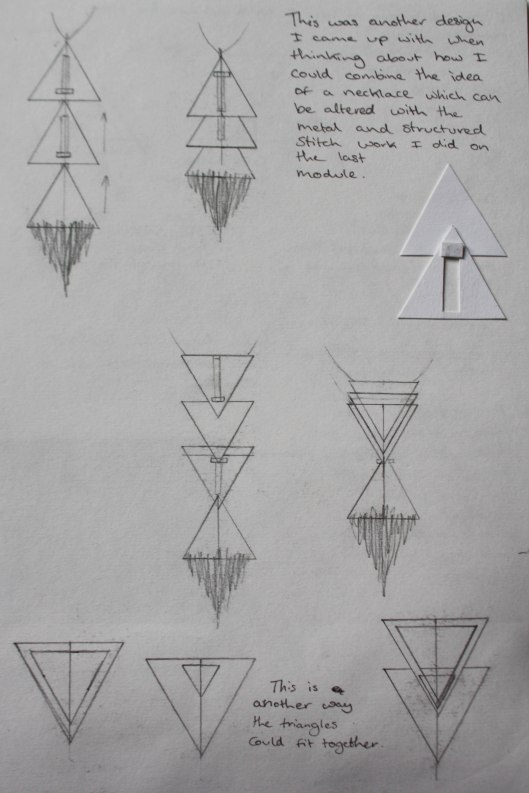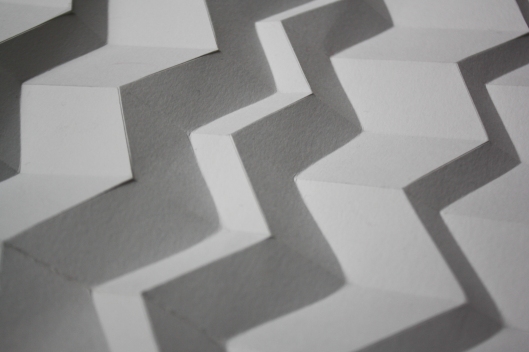Next month I will be running some jewellery making workshops in Neath, Port Talbot. The first is this Paper and Silver Jewellery Workshop. Below are some examples of what you can make.
Category Archives: Paper
Paper to Metal
A large part of why I chose to explore folds in metal was because of how much work I have done in the past with paper. During both my Foundation year and the first year of my degree I did a lot of work in paper, card and acetate. In my latest project, making the corridors, I made lots of maquettes in different papers and cards but then struggled in understanding how to replicate these forms in metal.
I did succeed in making my ‘corridors’ in metal however I felt that to push the designs forward and make more varied pieces, like I had in paper, I would need have a better understanding of how differently metal and paper need to be treated.
Therefore, it made sense to do a section of my metal folding project comparing the results of a few paper-folding techniques in both card and brass.
 With both the card and metal I scored the lines first and then bent along them accordingly. I used the wire scoring technique to do the brass samples.
With both the card and metal I scored the lines first and then bent along them accordingly. I used the wire scoring technique to do the brass samples.
With this first form I found the results to be very similar.
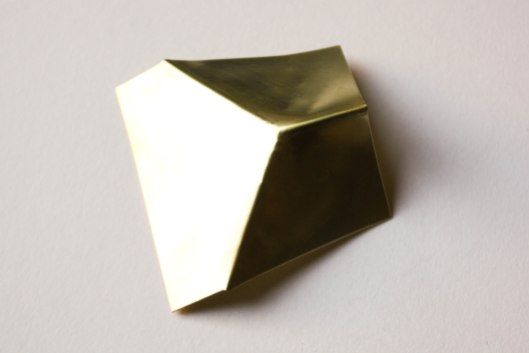

 With this second paper-folding technique I had to work a lot harder on the metal however the result was still very similar the only significant difference being the loss of the point in the centre of the metal where all the lines meet.
With this second paper-folding technique I had to work a lot harder on the metal however the result was still very similar the only significant difference being the loss of the point in the centre of the metal where all the lines meet.


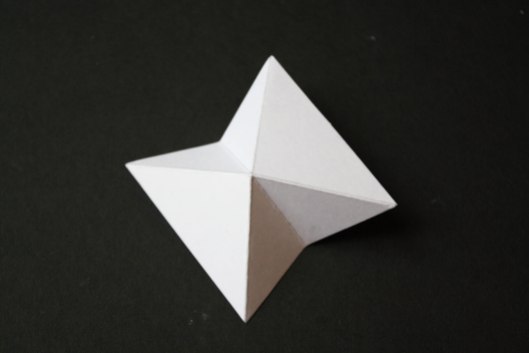 With this last pair the results were really quite different. Again, the main difficulty was with recreating the point in the centre where all the lines meet. Although this was the least successful in the recreation the result was still interesting and effective.
With this last pair the results were really quite different. Again, the main difficulty was with recreating the point in the centre where all the lines meet. Although this was the least successful in the recreation the result was still interesting and effective.
 During the project I didn’t have time to test out these techniques in copper but I would still be interested in comparing the results as copper is so much softer than brass.
During the project I didn’t have time to test out these techniques in copper but I would still be interested in comparing the results as copper is so much softer than brass.
Paper Jewellery
I decided not to use the optical illusion work as I prefer the subtlety of the previous work. However, I was still not sure exactly what I was making, at the time they were just art objects. I questioned myself on whether they needed to be something more. To work out if these little corridors could become jewellery I tried out some of my favourite paper pieces on chains as necklaces.
 The small ones are quite sweet, they could make interesting beads.
The small ones are quite sweet, they could make interesting beads. I tried playing around with the positioning of the paper corridors on the chain, looking at how they might sit on the body.
I tried playing around with the positioning of the paper corridors on the chain, looking at how they might sit on the body. 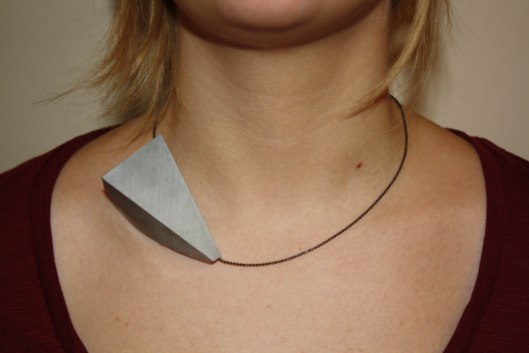 I felt that some of the pieces were a bit to large to be worn this way, they didn’t look quite right. Also, whilst they are in paper and therefore quite light, if I was to translate them into metal they may be a bit too heavy to be comfortable to wear.
I felt that some of the pieces were a bit to large to be worn this way, they didn’t look quite right. Also, whilst they are in paper and therefore quite light, if I was to translate them into metal they may be a bit too heavy to be comfortable to wear.  This one was particularly interesting with its steep curve and point. It works quite well as an asymmetrical neck piece.
This one was particularly interesting with its steep curve and point. It works quite well as an asymmetrical neck piece.
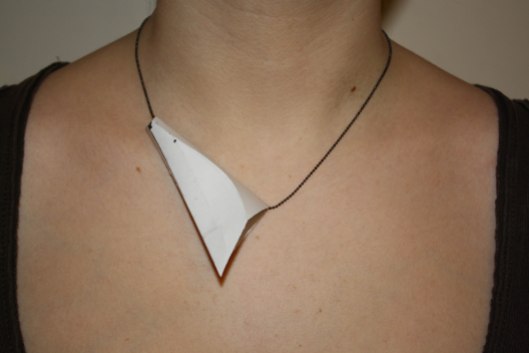 After doing this I definitely think that some of the smaller ‘corridors’ could work very well as metal neck pieces, however, I am still interested in making some of the larger ones into art objects which are meant to be held, looked at and looked through.
After doing this I definitely think that some of the smaller ‘corridors’ could work very well as metal neck pieces, however, I am still interested in making some of the larger ones into art objects which are meant to be held, looked at and looked through.
Optical Illusions
Another idea I played with during my Gallery project was that of optical illusions. This was inspired by the illusions which can be seen in MIMA’s cafe. See the photos my dad took of these illusions here.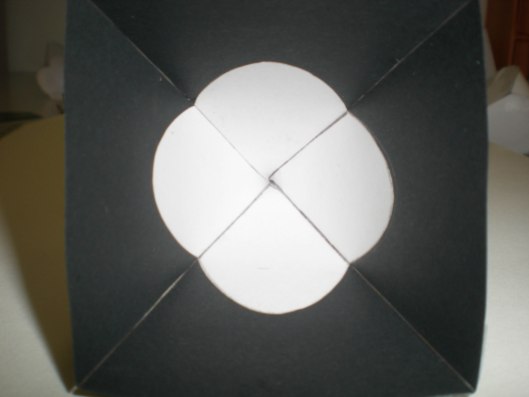 I tried to incorporate the illusion of a circle within my corridor forms, although those forms became pyramids as I closed off the narrow end. I started by drawing the circles, working out how to change the curves to create the illusions, by eye.
I tried to incorporate the illusion of a circle within my corridor forms, although those forms became pyramids as I closed off the narrow end. I started by drawing the circles, working out how to change the curves to create the illusions, by eye. Soon after, I worked out how to create a net pattern on Photoshop to get a more accurate circle. Once I had this figured out I was able to change the shape and positioning of the illusion.
Soon after, I worked out how to create a net pattern on Photoshop to get a more accurate circle. Once I had this figured out I was able to change the shape and positioning of the illusion.
Oval:
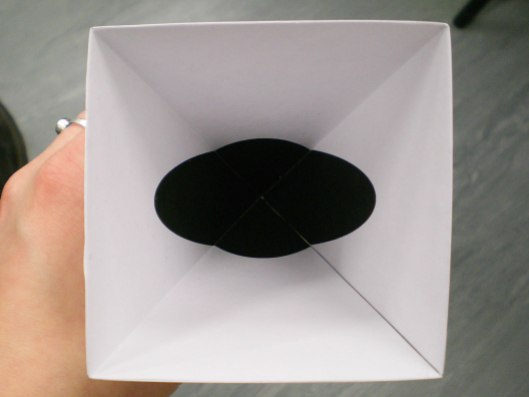 Off-centre circle:
Off-centre circle:
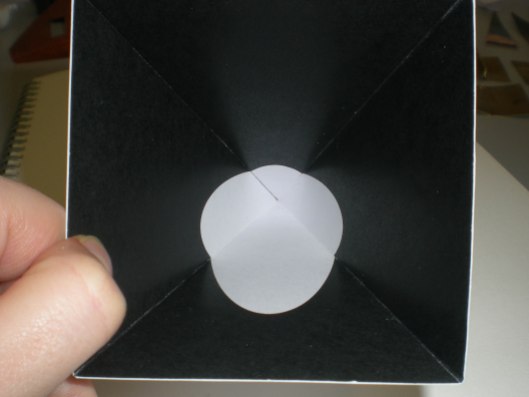 However, I then wanted to incorporate the earlier idea of curving one of the edges of the form but this proved much more difficult. I simply couldn’t work out how to alter the circle’s curves to accommodate for the curved edge and still create a perfect illusion of a circle. I attempted drawing it by hand (below) but gave up all together on Photoshop.
However, I then wanted to incorporate the earlier idea of curving one of the edges of the form but this proved much more difficult. I simply couldn’t work out how to alter the circle’s curves to accommodate for the curved edge and still create a perfect illusion of a circle. I attempted drawing it by hand (below) but gave up all together on Photoshop.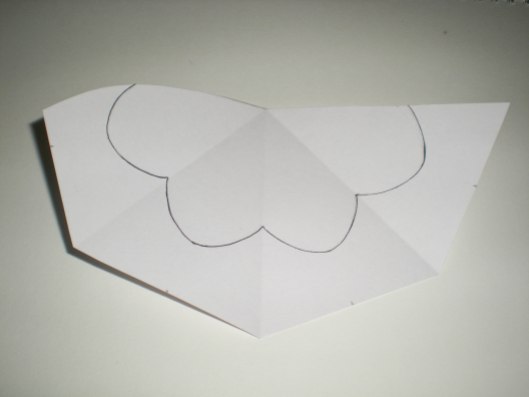
 Another aspect of these objects which proved tricky was photographing, or even seeing, the illusions. You have probably noticed that the illusions don’t actually seem to work in any of these photos but I promise that it is because they don’t photograph well. If you were to see them in reality you’d be able to tell that they do work, well, they do as long as you squint or hold them at a distance… haha. Maybe I’ve just been looking at them for too long!
Another aspect of these objects which proved tricky was photographing, or even seeing, the illusions. You have probably noticed that the illusions don’t actually seem to work in any of these photos but I promise that it is because they don’t photograph well. If you were to see them in reality you’d be able to tell that they do work, well, they do as long as you squint or hold them at a distance… haha. Maybe I’ve just been looking at them for too long!
Image and Reflection
My most recent project – the gallery one – actually came to an end over a week ago and I have even had my mark back awhile.
However, I have only done 2 posts about this project so far. Which is a pity as I have been really pleased with the work I have produced and the ideas I have been working with. Therefore, I am not going to post photos of my final work or tell you what mark I got just yet. I hope to post some more work that led to the projects conclusion first.
So, here are some more images of the paper pieces I made, experimenting with pattern and surfaces.
 These were done using printed photos of the Mission’s interior. I like the subtle colour changes and how the folds change the intersecting lines of the images.
These were done using printed photos of the Mission’s interior. I like the subtle colour changes and how the folds change the intersecting lines of the images.


I then bought some Silver card (or mirror paper) to create reflections inside these corridor forms. I tried changing aspects to see how this changed the reflections. In this next one I used the mirror paper on only one side whilst colouring in the opposite section. This created the appearance of an extra two sides or, as I see it, a path.
I tried changing aspects to see how this changed the reflections. In this next one I used the mirror paper on only one side whilst colouring in the opposite section. This created the appearance of an extra two sides or, as I see it, a path.
 Finally, I tried cutting out windows. This created a repeat pattern and obviously allowed more light inside the ‘corridor’.
Finally, I tried cutting out windows. This created a repeat pattern and obviously allowed more light inside the ‘corridor’.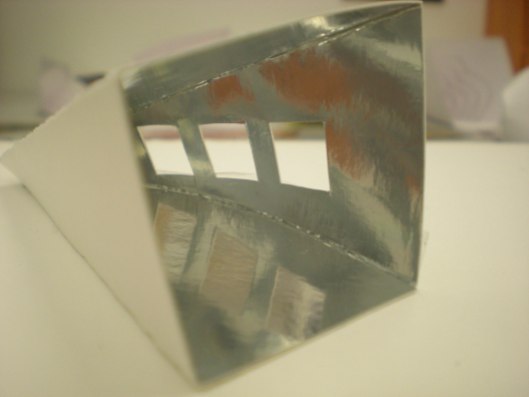

Happy New Year
Well Happy New Year everyone! I hope you all had a great night last night as well as a fantastic Christmas. These are pictures of another of my paper ‘corridors’. Again it is inspired by John Pym’s installation “Penumbra” but with this one I have also focused on the iconic windows of Mission Gallery.
These are pictures of another of my paper ‘corridors’. Again it is inspired by John Pym’s installation “Penumbra” but with this one I have also focused on the iconic windows of Mission Gallery.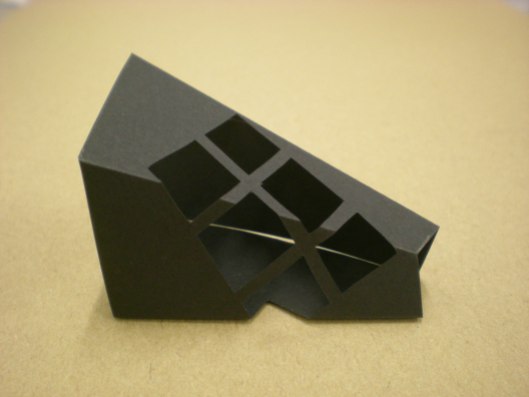 These ‘corridors’ are great for looking at from various angles, changing the perspective alters how they appear quite a lot.
These ‘corridors’ are great for looking at from various angles, changing the perspective alters how they appear quite a lot. I particularly like this one, I’m not sure why, but at least a part of it is the use of black paper. Although it is all black the windows allowing light through still create different shades and depth.
I particularly like this one, I’m not sure why, but at least a part of it is the use of black paper. Although it is all black the windows allowing light through still create different shades and depth.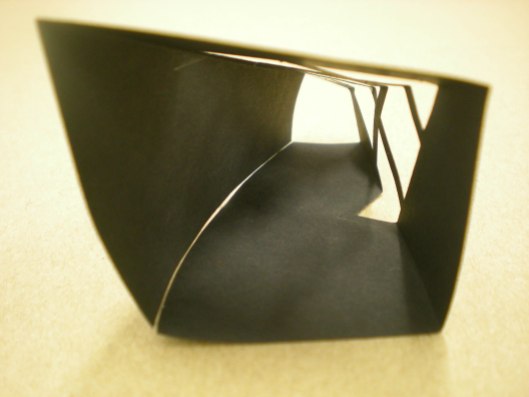
Paper Corridors
Wow! So far second year has been unbelievably busy (part of the reason for the lack of posts). I have been working on 3 projects and an essay, all running at once! Luckily one project and the essay are over and done with now and I got 82 on my essay, a fantastic mark, giving me a first. Yay!
My main brief at the moment is to design and make a collection of work based on a specific museum or gallery of our choice. The idea is that the products we create would be sold in the shop of the museum or gallery.
I have chosen two galleries to base my work upon; Mission Gallery and MIMA.
I have been making lots of paper objects based on aspects of both galleries. These first ones were inspired by Mission Gallery’s building and the John Pym exhibition ‘Penumbra‘.

With these I was creating miniature corridors, joining curved and straight edges, and playing with ideas of perception of space, sense of depth and light and shadow.


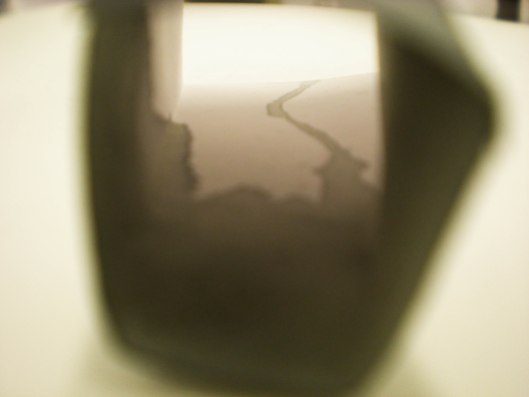

Result!
Just two days ago I was moving out of my student house in Hereford. It’s hard to believe my first year has finished!
Since returning home I have received a letter confirming my results. For my final project, the work below, I received 80! A very good 1st.
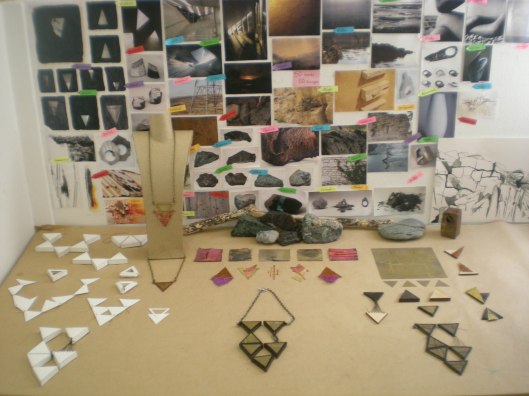
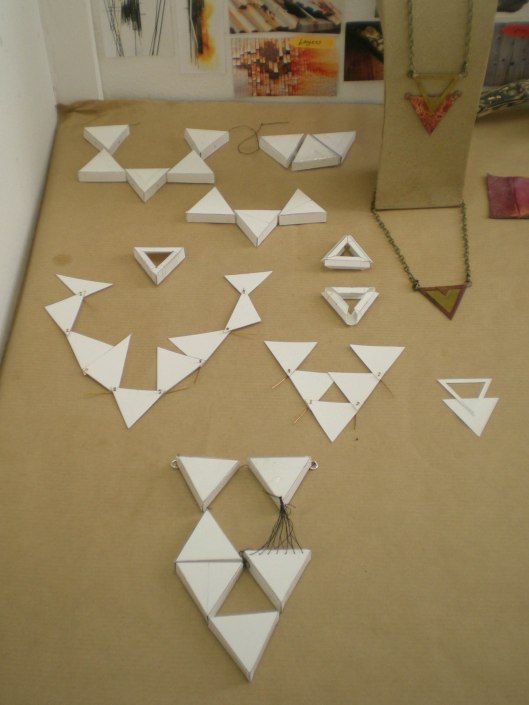
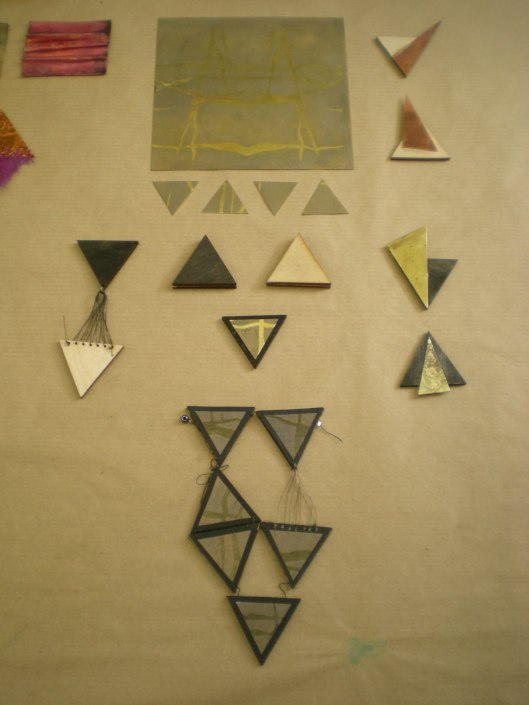
Obviously I am very pleased with my result but, although the project itself was very successful, I will admit I was a little disappointed that the actual final necklace wasn’t completely successful. You can see this below.

Having said that I still think elements of it are very effective and the initial design very clever.
My overall mark for the whole year is 1st. Yay!
Necklace Designs
Today I finished my final necklace for my current project. The deadline is this Friday and I still have a bit of book work to do but it is a big relief to have the final outcome over and done with!
Before I present the final piece I want to show some of the journey towards my final design with some of my ideas in my sketchbook.

